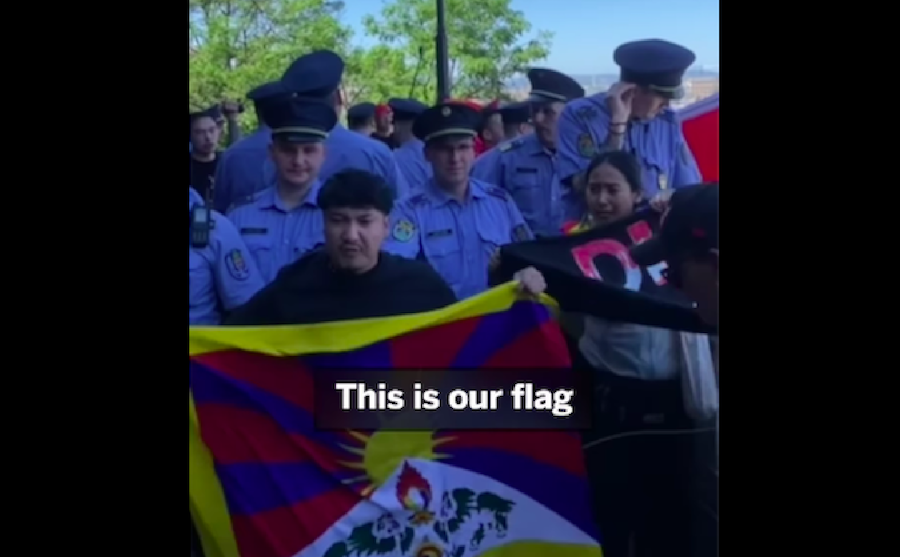Film Review by Dechen Pemba
(Tibetan Review May 2006)
 With a non-existent Tibetan film industry it must have been quite the challenge to bring this project to the big screen but Dreaming Lhasa succeeds admirably on many important levels. It is an intelligent, professionally made and thought-provoking feature film reflecting the current situation facing Tibetans in exile. The intriguing story, likeable characters and universal themes of identity, love and dislocation are more than enough to hold the attention for ninety minutes and the film deserves a much wider audience, as a great small independent film made by skilled filmmakers, far beyond the scope of the current film festival circuit.
With a non-existent Tibetan film industry it must have been quite the challenge to bring this project to the big screen but Dreaming Lhasa succeeds admirably on many important levels. It is an intelligent, professionally made and thought-provoking feature film reflecting the current situation facing Tibetans in exile. The intriguing story, likeable characters and universal themes of identity, love and dislocation are more than enough to hold the attention for ninety minutes and the film deserves a much wider audience, as a great small independent film made by skilled filmmakers, far beyond the scope of the current film festival circuit.
Dreaming Lhasa’s protagonist is an American-Tibetan woman, Karma, who is on a journey of self-discovery, exploring her roots and her Tibetan identity.
Karma is in Dharamsala, the capital of Tibetans in exile in northern India, making a documentary film about the Tibetan diaspora and we see her interviewing ex-political prisoners (playing themselves). Her assistant, Jigme, is a typical young and restless Dharamsala guy, born in India, aimless but dreaming of a brighter future in America the promised land.
Karma’s path crosses with Dhondup’s – another Tibetan also on a personal journey. Dhondup is a recent escapee from Tibet in Dharamsala and on a quest to fulfil his mother’s dying wish to return a charm box to an old acquaintance of hers called Loga. Together they embark on an adventure as they delve deeper and deeper into the story of the mysterious Loga and his charm box that leads them to a string of different faces, encounters and places. The plot unfolds, twists and turns in an unexpected and gripping manner reminiscent of a good old-fashioned mystery thriller. Tibet’s past and present are skilfully interwoven and all the while Karma and Dhondup’s respective journeys are bringing them closer and closer to each other.
The plot really starts to thicken on discovery of a cyanide pill inside Loga’s charm box, bringing a largely unknown part of modern Tibetan history to the foreground, namely the plight of the Tibetan freedom fighters who fought a guerrilla war against the Chinese invaders and were funded and trained by the CIA in the cold war era. The film is thus able to convey complex messages not only on the current Tibetan predicament but also connects the spirit of resilience and defiance by Tibetans over the generations.
From the forgotten freedom fighters of a fading generation (some of whom appear in the film) to the peaceful demonstrations of the Tibetans to those youths engaging in hunger strikes as a last resort, the question is posed as to where the Tibetan struggle is going and whether the Tibetan youths as portrayed in the film will also one day be another generation dying in exile from their ‘native’ country. Karma’s immersion into this exile-Tibetan world and culture, the demonstrations, the anger, frustration and sadness, the testimonies of the ex-political prisoners in turn touch and bewilder her as she finds herself torn between worlds, the difficult relationship and the life she left behind in America and her Tibetan roots. Her American accent as she speaks stilted Tibetan very much reveals her dislocated identity.
Although Karma’s character is weakly fleshed out in the film, first-time actress Tenzin Chokyi Gyatso makes for a sympathetic lead. Similarly, Tenzin Jigme, playing Karma’s assistant Jigme, is very likeable and tackles the role with enthusiasm. However, the outstanding actor in Dreaming Lhasa is undoubtedly Jampa Kalsang whose layered, thoughtful portrayal of Dhondup is outstanding. He simply looks, talks and walks the part of a refugee just escaped from Tibet right down to the subtle details such as the way he wears his jacket over his shoulders.
For Tibetan viewers there will be much to admire and enjoy in the film, not least because it manages to avoid striking any false notes and instead reflects so accurately the Tibetans in exile. From the charming opening sequence down to the STD phone booths in India, the stickers on the walls of the Tibetan homes, a mobile phone Tibetan pop song ringtone and the Dharamsala youths who are obsessed with visas to the US – all these details are the observations of insiders who know this community inside out. The film falls superbly into place, perhaps too neatly one could argue, however there is something uniquely Tibetan about the cyclical plotline where the starting point for the characters also becomes the point where it ends – the journey comes full circle. The filmmakers have adeptly managed to depict a cross-section of the diaspora without pity or a hint of maliciousness. The fact that the film never once shows Tibet or the Lhasa of the film’s title is just as in real life. For so many Tibetans born in exile, Tibet is significant as an absence, an omnipresent looming all-encompassing void which here is manifested in practically every single person or object shown on the screen.
Steering well clear of romantic notions of Tibet favoured by filmmakers, there are no majestic mountain landscapes, saffron soaked images, levitating monks or dharma claptrap here. Even Tibet’s most famous face, the Dalai Lama, only makes a fleeting appearance. Dreaming Lhasa prefers to tell it like it is and powerfully depicts the unglamorous realities of a people in exile – the frustration of youth, the hopes and regrets of older generations, the struggle to survive and the fractured nature of displaced identities with refreshing honesty – accompanied by a generous amount of personal affection and humour.
For more information visit: www.dreaminglhasa.com The reviewer saw Dreaming Lhasa at the 2006 Bangkok International Film Festival and can be contacted on dpemba@hotmail.com









